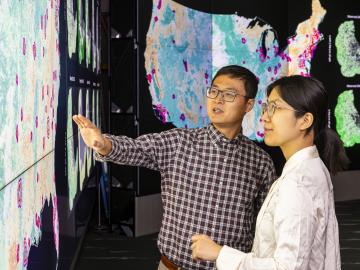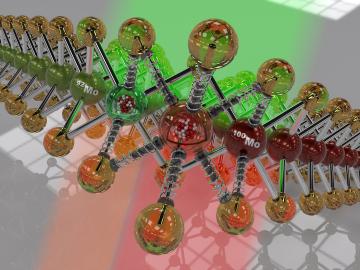Filter News
Area of Research
- Advanced Manufacturing (29)
- Biological Systems (16)
- Biology and Environment (116)
- Biology and Soft Matter (1)
- Building Technologies (10)
- Chemical and Engineering Materials (1)
- Chemistry and Physics at Interfaces (5)
- Clean Energy (397)
- Climate and Environmental Systems (6)
- Computational Biology (5)
- Computational Engineering (4)
- Computer Science (14)
- Data (1)
- Electricity and Smart Grid (1)
- Energy Frontier Research Centers (8)
- Energy Sciences (4)
- Fossil Energy (3)
- Fuel Cycle Science and Technology (1)
- Functional Materials for Energy (7)
- Fusion and Fission (28)
- Fusion Energy (10)
- Geographic Information Science and Technology (2)
- Isotope Development and Production (3)
- Isotopes (22)
- Materials (312)
- Materials Characterization (2)
- Materials for Computing (23)
- Materials Synthesis from Atoms to Systems (6)
- Materials Under Extremes (6)
- Mathematics (1)
- National Security (48)
- Neutron Data Analysis and Visualization (2)
- Neutron Science (120)
- Nuclear Science and Technology (47)
- Nuclear Systems Modeling, Simulation and Validation (3)
- Nuclear Systems Technology (1)
- Quantum Condensed Matter (1)
- Quantum information Science (4)
- Reactor Technology (1)
- Renewable Energy (3)
- Sensors and Controls (4)
- Supercomputing (157)
- Transportation Systems (7)
News Type
Date
News Topics
- 3-D Printing/Advanced Manufacturing (85)
- Advanced Reactors (25)
- Artificial Intelligence (44)
- Big Data (28)
- Bioenergy (55)
- Biology (59)
- Biomedical (36)
- Biotechnology (13)
- Buildings (38)
- Chemical Sciences (43)
- Clean Water (20)
- Climate Change (56)
- Composites (20)
- Computer Science (108)
- Coronavirus (34)
- Critical Materials (23)
- Cybersecurity (26)
- Decarbonization (38)
- Education (3)
- Element Discovery (1)
- Energy Storage (84)
- Environment (115)
- Exascale Computing (12)
- Fossil Energy (1)
- Frontier (17)
- Fusion (29)
- Grid (42)
- High-Performance Computing (45)
- Hydropower (8)
- Irradiation (2)
- Isotopes (29)
- ITER (6)
- Machine Learning (27)
- Materials (99)
- Materials Science (93)
- Mathematics (4)
- Mercury (9)
- Microscopy (36)
- Molten Salt (7)
- Nanotechnology (44)
- National Security (33)
- Net Zero (6)
- Neutron Science (84)
- Nuclear Energy (56)
- Partnerships (27)
- Physics (44)
- Polymers (25)
- Quantum Computing (14)
- Quantum Science (39)
- Renewable Energy (1)
- Security (17)
- Simulation (18)
- Space Exploration (13)
- Statistics (3)
- Summit (28)
- Sustainable Energy (87)
- Transformational Challenge Reactor (4)
- Transportation (72)
Media Contacts

Scientists at ORNL completed a study of how well vegetation survived extreme heat events in both urban and rural communities across the country in recent years. The analysis informs pathways for climate mitigation, including ways to reduce the effect of urban heat islands.

A collection of seven technologies for lithium recovery developed by scientists from ORNL has been licensed to Element3, a Texas-based company focused on extracting lithium from wastewater produced by oil and gas production.

Research led by scientists at ORNL has demonstrated that small changes in the isotopic content of thin semiconductor materials can influence their optical and electronic properties, possibly opening the way to new and advanced designs with the semiconductors.
Luke Bertels, a Eugene P. Wigner Fellow, is helping determine ways to combine artificial intelligence and quantum computing, specifically to develop classical and quantum machine learning methods for using adaptive neural networks to study correlated molecules and chemical systems.

Scientists at the Department of Energy’s Oak Ridge National Laboratory have developed lubricant additives that protect both water turbine equipment and the surrounding environment.

Groundwater withdrawals are expected to peak in about one-third of the world’s basins by 2050, potentially triggering significant trade and agriculture shifts, a new analysis finds.

Cheekatamarla is a researcher in the Multifunctional Equipment Integration group with previous experience in product deployment. He is researching alternative energy sources such as hydrogen for cookstoves and his research supports the decarbonization of building technologies.
Auburn University’s McCrary Institute for Cyber and Critical Infrastructure Security was awarded a $10 million DOE grant in partnership with ORNL to create a pilot regional cybersecurity research and operations center to protect the electric power grid against cyber attacks.

Inspection technology developed by Oak Ridge National Laboratory will help deliver plasma heating to the ITER international fusion facility.
Chemists at ORNL have invented a more efficient way to extract lithium from waste liquids leached from mining sites, oil fields and used batteries. They demonstrated that a common mineral can adsorb at least five times more lithium than can be collected using previously developed adsorbent materials.




